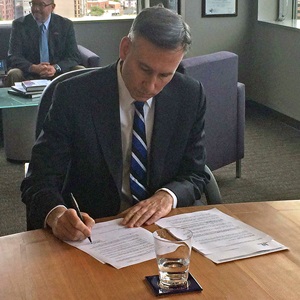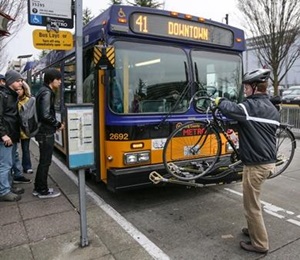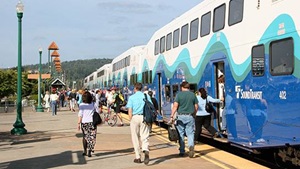Joint planning of region's bus and rail will create efficiencies and enable future service expansion
Summary
King County Executive and Sound Transit Board Chair Dow Constantine today acted to change the way local and regional transit agencies do business by increasing joint planning and integration to create greater operating efficiencies and enable future service expansion.
Story
 King County Executive and Sound Transit Board Chair Dow Constantine acted to change the way local and regional transit agencies do business by increasing joint planning and integration to create greater operating efficiencies and enable future service expansion.
King County Executive and Sound Transit Board Chair Dow Constantine acted to change the way local and regional transit agencies do business by increasing joint planning and integration to create greater operating efficiencies and enable future service expansion.“It is essential for transit agencies with overlapping jurisdictions to fully integrate their services, and provide them to the public as efficiently as possible,” said Constantine. “Long term, our transportation future requires both adequate revenue and continuous innovation to expand service. This initiative advances the innovation half of that equation.”
As County Executive, Constantine signed an Executive Order (pictured at right) directing the King County Department of Transportation to work in concert with Sound Transit on joint planning of bus service and full integration of buses and rail. As Chair of the Sound Transit Board, he will submit a companion motion for consideration on June 26.
Taken together, the measures call for:
- Integrating bus and rail service to make full use of the significantly greater operating speeds, reliability and capacity of rail and RapidRide.
- Putting savings into improving local service and regional connections – setting the stage for the start-up of University Link service from downtown Seattle to Capitol Hill and the University of Washington in early 2016.
- Maximizing efficiency by accelerating the full coordination of scheduling, operations, maintenance, administration, transparency, and accountability measures.
- Keeping a focus on equity, sustainability, and serving transit-dependent populations.
- Optimizing coordinated planning for major transit hubs to ensure seamless access to all modes of transportation.
- Further integrating rider information tools, such as online trip planners.
- Integrating planning with state highways, ferries, and other modes.
“As central Puget Sound continues to grow, we must work together to improve the way we provide transportation options across the region,” said Snohomish County Executive John Lovick. “I applaud Executive Constantine’s effort to coordinate regional transit service.”


Avoiding redundant services has particularly high potential to expand the reach and effectiveness of transit service. For example, when Northgate Link opens in 2021, directing bus routes to connect with light rail at the new Northgate and Roosevelt stations will keep riders out of some of the region’s worst congestion. Instead, they can take advantage of light rail that operates every six minutes during rush hour with highly reliable travel times of 14 minutes or less.
“At the end of the day, the public wants all of our transit agencies to work efficiently as an integrated system,” said Everett City Councilmember Paul Roberts, vice-chair of the Sound Transit Board. “This is an important step to continuing our commitment to make transit agencies more efficient, by working together and integrating our planning efforts.”
"I fully support an integrated regional transit system where all transit agencies work together to achieve operating efficiencies and cost-saving wherever possible,” said Issaquah Mayor Fred Butler, chair of the Sound Transit Capital Budget Committee.
Better integration
Metro and Sound Transit already jointly operate rail and bus services in the Downtown Seattle Transit Tunnel, collaborate to deliver the regional ORCA fare system with more than 400,000 daily transactions, and conduct community outreach in concert with system planning. The agencies successfully built new transit ridership by integrating Metro buses, RapidRide and Sound Transit trains with the 2009 start of Link service.
Sound Transit also contracts with Metro to operate Link Light Rail and ST Express bus services, and the agencies work together to manage more than 25,000 park-and-ride spaces, transit centers, and rail facilities throughout King County. The initiative will not change the responsibility of each governing body to maintain accountability to its own taxpayers.
Next steps
Constantine said he expects staff at Sound Transit and Metro to present an integration report with conclusions and recommendations by September. Those plans will address the implementation of Metro service reductions and restructures this fall and in 2015, and the start-up of University Link service in early 2016.

 Translate
Translate

